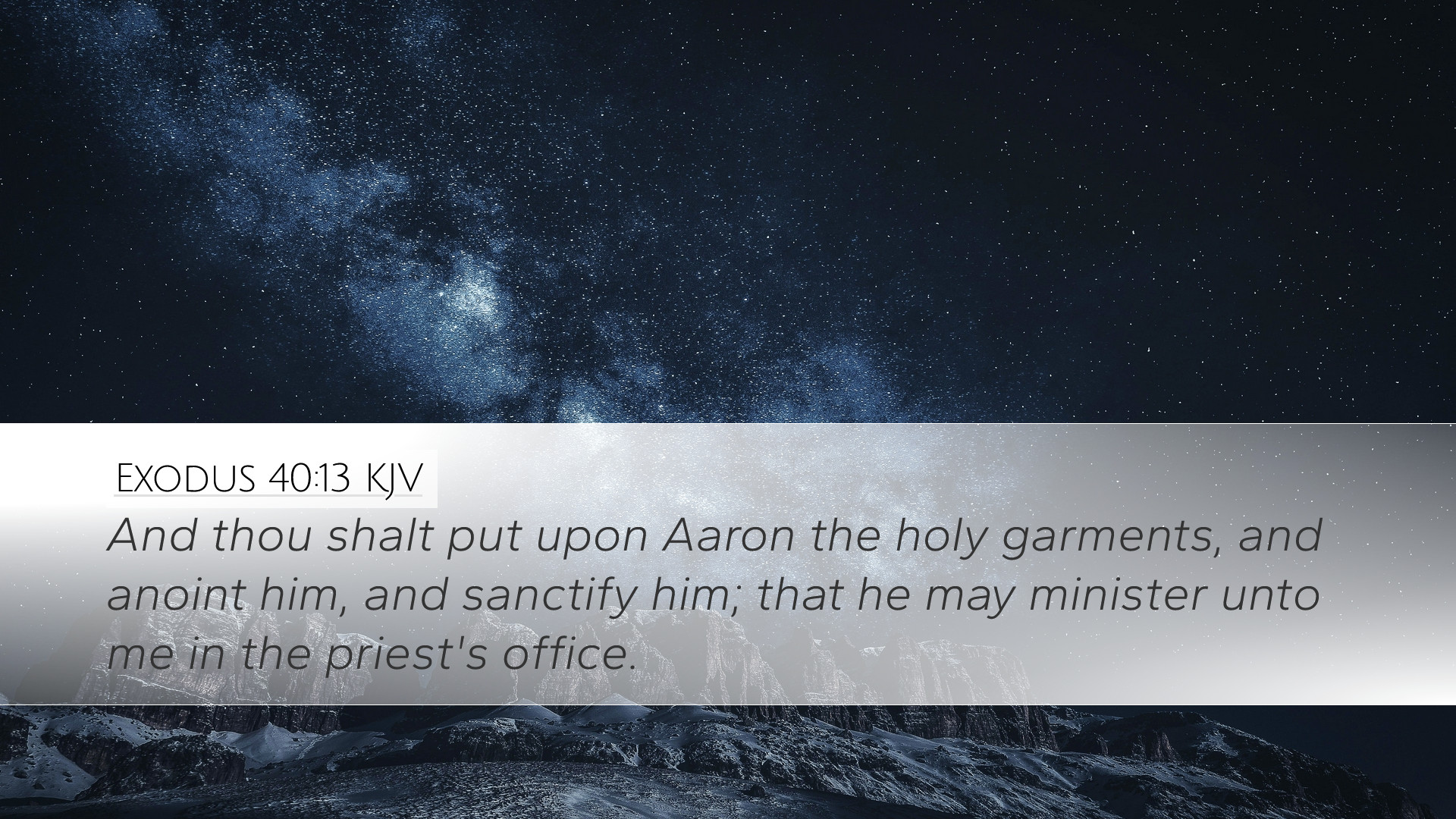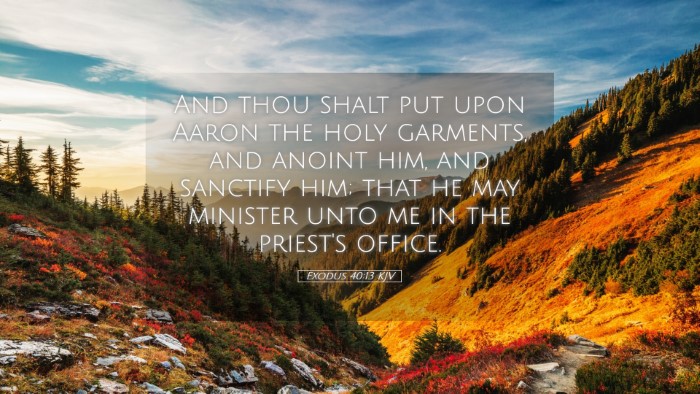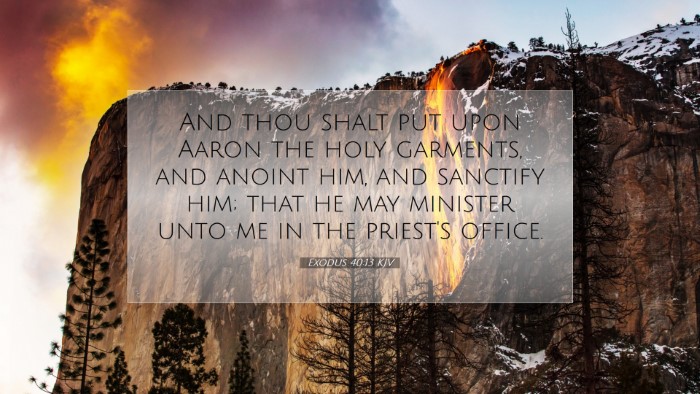Bible Commentary on Exodus 40:13
Verse: Exodus 40:13 - "And thou shalt put upon Aaron the holy garments, and anoint him, and sanctify him; that he may minister unto me in the priest's office."
Introduction
The verse in Exodus 40:13 marks a significant moment in the establishment of the priestly office among the Israelites. This passage not only gives instructions for the attire of Aaron, the first high priest, but underscores the vital themes of holiness, anointing, and the sacred responsibilities of priestly service. In this commentary, we draw insights from renowned public domain sources to delve into the theological, historical, and practical implications of this verse.
Overview of the Context
To fully grasp the significance of Exodus 40:13, we must understand the broader context of the entire Exodus narrative. After the exodus from Egypt, the Israelites are given detailed instructions for building the Tabernacle, a central place of worship. Aaron, as Moses’ brother, is designated as the first high priest, setting the stage for the Levitical priesthood that follows.
The Significance of the Holy Garments
Matthew Henry emphasizes the importance of the "holy garments" which symbolize dignity and the divine nature of the priest's calling. The garments themselves consisted of a special ephod, a breastplate, and other ceremonial attire to visually represent the glory and holiness of God. The act of wearing these garments is a reminder of the seriousness of the priest's role in mediating between God and the people.
Albert Barnes explains that these garments were not mere clothing but an integral part of Aaron's consecration process. They denoted his authority and responsibility, distinguishing him from ordinary men. The elaborate nature of these garments reflects the majesty associated with the service of God, highlighting how those who serve in sacred offices are called to a higher standard of holiness.
Anointing and Sanctification
The verse states, "and anoint him, and sanctify him." This segment is vital as it relates to the anointing, which signifies the empowerment of the Holy Spirit. Adam Clarke elaborates that anointing with oil serves as a physical symbol of God’s consecration, setting apart Aaron and his successors for the priestly duties. This act highlights the divine endorsement upon individuals chosen for God’s work.
In the process of sanctification mentioned in the verse, we see an acknowledgment that the priest's role requires moral and spiritual purity. Matthew Henry notes that only those who are consecrated and sanctified through this divine process are fit to minister in God’s presence. This dual concept of being anointed and sanctified is essential for understanding the seriousness of the priesthood and the sanctity of spiritual leadership.
Ministering in the Priest's Office
The phrase "that he may minister unto me in the priest's office" reflects the ultimate purpose of the anointing and sanctification. Albert Barnes notes that the role of the priest is one of service, an intermediary who connects the people with God. This responsibility includes offerings, prayers, and rituals that facilitate the worship of God. The covenantal relationship between God and Israel is mediated through such office bearers.
Adam Clarke adds that the ministerial role of a priest encompasses more than rituals; it represents the character of divine service itself. By fulfilling his duties, the priest embodies the holiness of God, exemplifying a life set apart in devotion and service to the community. Clarke emphasizes how this model of ministry has implications for contemporary leaders in the church today, urging them to reflect God’s holiness in their lives and service.
Theological Implications
This verse reveals profound theological implications, particularly concerning the nature of holiness and service. Matthew Henry points out that God's holiness is a central theme throughout Scripture, and those who approach Him must do so on sacred ground. The act of anointing and the requirement of holy garments signify that approaching God is not to be taken lightly; it involves preparation, respect, and acknowledgment of His greatness.
Albert Barnes further elaborates that these principles should guide present-day ministry. The call to serve in a spiritual capacity today retains its dignity and requires individuals to be set apart for God’s work. The priesthood of believers as articulated in the New Testament draws a direct parallel, emphasizing that all Christians are called to exhibit lives that reflect God's holiness and serve others in His name.
Practical Applications
For pastors, students, and theologians, Exodus 40:13 invites several practical applications:
- Understanding the Sacred: All who serve in spiritual leadership must recognize the gravity of their calling. Just as Aaron’s anointing was essential for his ministry, modern leaders must seek God's empowerment and guidance through prayer and the study of Scripture.
- Cultivating Holiness: The requirement for holiness in the priesthood serves as a reminder to pursue personal integrity and accountability. Leaders should exemplify Christ-like character in both private and public life.
- Emphasizing Service: Those who lead in ministry should adopt a servant-leader model, prioritizing the needs of the congregation and addressing the spiritual and practical aspects of ministry with humility and grace.
Conclusion
Exodus 40:13 encapsulates the essence of the priestly office and its associated privileges and responsibilities. The instructions provided for Aaron's anointing and attire speak to the heart of worship, divine service, and God's demand for holiness. In a society where the sacred is often treated casually, this verse serves as a clarion call to reverence, commitment, and serious reflection on the nature of spiritual leadership.


